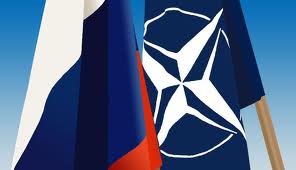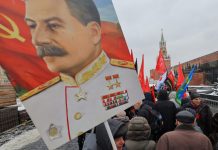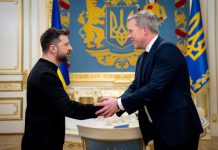Since Russia began its illegal military intervention in Ukraine, Russian officials have accused NATO of a series of provocations, threats and hostile actions stretching back over 25 years. This webpage sets out the facts.
NATO and its attitude to Russia
Claim: NATO has a Cold War mentality
Fact: The Cold War ended over 20 years ago. It was characterized by the opposition of two ideological blocs, the presence of massive standing armies in Europe, and the military, political and economic domination by the Soviet Union of almost all its European neighbours.
The modern world does not feature competing ideological blocs: Russia has neither a credible ideology to export, nor significant international allies who support its aggressive actions in and around Ukraine. In fact, in a vote in the United Nations General Assembly on 23 March 2014, 100 countries voted that Russia’s attempted annexation of Crimea was illegal, and just 10, other than Russia, supported it (resolution and voting record online here).
The end of the Cold War was a victory for the people of Central and Eastern Europe and the former Soviet Union, and opened the way to overcoming the division of Europe. At pathbreaking Summit meetings in the years after the fall of the Berlin Wall, Russia played its part in building a new, inclusive European security architecture, including the Charter of Paris, the establishment of the OSCE, and the NATO-Russia Founding Act.
Over the past decades, NATO reached out to Russia with a series of partnership initiatives, culminating in the foundation of the NATO-Russia Council in 2002. No other country has such a privileged relationship with NATO.
As stated by NATO heads of state and government at the Wales Summit in September, “the Alliance does not seek confrontation and poses no threat to Russia. But we cannot and will not compromise on the principles on which our Alliance and security in Europe and North America rest.” (The Wales Summit Declaration can be read here).
This is NATO’s official policy, defined and expressed transparently by its highest level of leadership.
Claim: NATO is a U.S. geopolitical project
Fact: NATO was founded in 1949 by twelve sovereign nations: Belgium, Canada, Denmark, France, Iceland, Italy, Luxembourg, the Netherlands, Norway, Portugal, the United Kingdom and the United States. It has since grown to 28 Allies.
All decisions in NATO are taken by consensus, which means that a decision can only be taken if every single Ally accepts it.
Equally, the decision for any country to take part in NATO-led operations falls to that country alone, according to its own legal procedures. No member of the Alliance can decide on the deployment of any other Ally’s forces.
Claim: NATO’s purpose is to contain or weaken Russia
Fact: NATO’s purpose is set out in the preamble to the Washington Treaty, the Alliance’s Founding document (online here ).
This states that Allies are determined “to safeguard the freedom, common heritage and civilisation of their peoples, founded on the principles of democracy, individual liberty and the rule of law. They seek to promote stability and well-being in the North Atlantic area. They are resolved to unite their efforts for collective defence and for the preservation of peace and security.”
In line with those goals, in the past two decades NATO has led missions in the Balkans, Afghanistan, over Libya and off the Horn of Africa. The Alliance has conducted exercises from the Mediterranean to the North Atlantic and across Europe, and on issues ranging from counter-terrorism to submarine rescue – including with Russia itself.
Claim: NATO has tried to isolate or marginalise Russia
Fact: Since the early 1990s, the Alliance has worked to build a cooperative relationship with Russia on areas of mutual interest.
NATO began reaching out, offering dialogue in place of confrontation, at the London NATO Summit of July 1990 (declaration here). In the following years, the Alliance promoted dialogue and cooperation by creating new fora, the Partnership for Peace (PfP) and the Euro-Atlantic Partnership Council (EAPC), open to the whole of Europe, including Russia (PfP founding documents here and here).
In 1997 NATO and Russia signed the Founding Act on Mutual Relations, Cooperation and Security, creating the NATO-Russia Permanent Joint Council. In 2002 they upgraded that relationship, creating the NATO-Russia Council (NRC). They reaffirmed their commitment to the Founding Act at NATO-Russia summits in Rome in 2002 and in Lisbon in 2010 (The Founding Act can be read here, the Rome Declaration which established the NRC here, the Lisbon NRC Summit Declaration here.)
Since the foundation of the NRC, NATO and Russia have worked together on issues ranging from counter-narcotics and counter-terrorism to submarine rescue and civil emergency planning. No other partner has been offered a comparable relationship, nor a similar comprehensive institutional framework.
Claim: NATO should have been disbanded at the end of the Cold War
Fact: At the London Summit in 1990, Allied heads of state and government agreed that “”We need to keep standing together, to extend the long peace we have enjoyed these past four decades“. This was their sovereign choice and was fully in line with their right to collective defence under the United Nations Charter.
Finally, any comparison between NATO and the Warsaw Pact or the Soviet bloc is an utter distortion of history. The fact is that when the countries of Central and Eastern Europe applied for NATO membership, it was of their own free choice, through their own national democratic processes, and after conducting the required reforms – unlike their incorporation into the Soviet bloc and the Warsaw Pact, which was carried out under conditions of military occupation, one-party dictatorship and the brutal suppression of dissent.
NATO as a “threat”
Claim: NATO is a threat to Russia
Fact: NATO has reached out to Russia consistently, transparently and publicly over the past 25 years.
The Alliance has created unique cooperation bodies – the Permanent Joint Council and the NATO-Russia Council – to embody its relationship with Russia. It has invited Russia to cooperate on missile defence, an invitation extended to no other partner.
In the Founding Act on Mutual Relations, Cooperation and Security, agreed with Russia in 1997 and reaffirmed at NATO-Russia summits in Rome in 2002 and in Lisbon in 2010, NATO stated that “in the current and foreseeable security environment, the Alliance will carry out its collective defence and other missions by ensuring the necessary interoperability, integration, and capability for reinforcement rather than by additional permanent stationing of substantial combat forces“. The Alliance has fulfilled all such commitments.
NATO’s official policy towards Russia was most recently articulated by the heads of state and government of the Alliance at the Wales Summit in September 2014 .
They stated that “the Alliance does not seek confrontation and poses no threat to Russia. But we cannot and will not compromise on the principles on which our Alliance and security in Europe and North America rest.” (The Wales Summit Declaration can be read here).
Thus, neither the Alliance’s policies nor its actions are a threat to Russia.
Claim: NATO missile defence is targeted at Russia
Fact: NATO’s official policy on missile defence was set out by heads of state and government at the Lisbon Summit in November 2010, where they “decided to develop a missile defence capability to protect all NATO European populations, territory and forces, and invited Russia to cooperate with us” (declaration here).
This was reiterated at the Chicago Summit in May 2012 (here) and the Wales Summit in September 2014, where leaders underlined that “NATO missile defence is not directed against Russia and will not undermine Russia’s strategic deterrence capabilities. NATO missile defence is intended to defend against potential threats emanating from outside the Euro-Atlantic area“.
NATO also proposed a transparency regime including the creation of two NATO-Russia joint missile-defence centres. Russia has declined these offers.
These Summit declarations are more than political promises: they define NATO’s policies. Rather than taking NATO up on cooperation, Russia has advanced arguments that ignore laws of physics as well as NATO’s expressed policies.
The NATO system is designed to be large enough to defend against limited attacks by states and non-state actors potentially threatening the Alliance. However, it still remains small enough not to fuel regional arms races. In terms of the types of interceptors, their numbers and locations, it is configured to defend against the principal threats to NATO’s European territory, and is not directed against Russia’s much larger and more sophisticated strategic deterrent forces. The interceptors to be deployed in Europe, including at the planned sites in Romania and Poland, are not designed to defend against intercontinental ballistic missiles. Their capabilities are too limited and their planned numbers too few.
Independent Russian experts have publicly agreed that the US European Phased Adaptive Approach and NATO’s missile defence system, even when fully developed, will have no appreciable impact on Russia’s numerous and highly sophisticated strategic nuclear forces. This has been documented in numerous scholarly articles by Russian generals and rocket scientists in Russian journals.
The Russian government has used missile defence as an excuse for accusations rather than an opportunity for partnership.
Claim: The accession of new Allies to NATO threatens Russia
Fact: Every country which joins NATO undertakes to uphold the principles and policies of the Alliance, and the commitments which NATO has already made.
This includes the commitment that NATO poses no threat to Russia, as most recently stated at the Wales Summit.
Therefore, as the number of countries which join NATO grows, so does the number of countries which agree that “the Alliance does not seek confrontation and poses no threat to Russia.”
Promises and pledges
Claim: NATO promised not to build infrastructure or move troops into the new Allies in Central and Eastern Europe.
Fact: The relationship between NATO and Russia is governed by the Founding Act on Mutual Relations, Cooperation and Security, agreed by NATO Allies and Russia in 1997 and reaffirmed at NATO-Russia summits in Rome in 2002, and in Lisbon in 2010. (The Founding Act can be read here.)
In the Founding Act, the two sides agreed that: “in the current and foreseeable security environment, the Alliance will carry out its collective defence and other missions by ensuring the necessary interoperability, integration, and capability for reinforcement rather than by additional permanent stationing of substantial combat forces. Accordingly, it will have to rely on adequate infrastructure commensurate with the above tasks. In this context, reinforcement may take place, when necessary, in the event of defence against a threat of aggression and missions in support of peace consistent with the United Nations Charter and the OSCE governing principles, as well as for exercises consistent with the adapted CFE Treaty, the provisions of the Vienna Document 1994 and mutually agreed transparency measures. Russia will exercise similar restraint in its conventional force deployments in Europe.”
Therefore, both infrastructure and reinforcements are explicitly permitted by the Founding Act.
Claim: NATO’s response to Russia’s illegal actions in Ukraine violates the Founding Act
Fact: NATO has responded to the new strategic reality caused by Russia’s illegal actions by reinforcing the defence of Allies in Central and Eastern Europe, and by ensuring the ability to increase those reinforcements if necessary, including by upgrading infrastructure.
All this is consistent with the Founding Act, quoted above.
In the Founding Act, all signatories, including Russia, agreed on principles which include “refraining from the threat or use of force against each other as well as against any other state, its sovereignty, territorial integrity or political independence in any manner inconsistent with the United Nations Charter and with the Declaration of Principles Guiding Relations Between Participating States contained in the Helsinki Final Act” and the “respect for sovereignty, independence and territorial integrity of all states and their inherent right to choose the means to ensure their own security, the inviolability of borders and peoples’ right of self-determination as enshrined in the Helsinki Final Act and other OSCE documents.”
NATO has respected those commitments faithfully. Russia, on the other hand, has declared the annexation of Crimea, supported violent separatists in the east of the country, and insisted that Ukraine be barred from joining NATO.
Claim: NATO leaders promised at the time of German reunification that the Alliance would not expand to the East
Fact: No such promise was ever made, and Russia has never produced any evidence to back up its claim.
Every formal decision which NATO takes is adopted by consensus and recorded in writing. There is no written record of any such decision having been taken by the Alliance.
Moreover, at the time of the alleged promise, the Warsaw Pact still existed. Its members did not agree on its dissolution until 1991. Therefore, it is not plausible to suggest that the idea of their accession to NATO was on the agenda in 1989.
This was confirmed by the former Soviet President Mikhail Gorbachev himself. This is what Mr Gorbachev said on 15 October 2014 in an interview with Rossiiskaya Gazeta and Russia Beyond The Headlines:
“The topic of ‘NATO expansion’ was not discussed at all, and it wasn’t brought up in those years. I say this with full responsibility. Not a single Eastern European country raised the issue, not even after the Warsaw Pact ceased to exist in 1991. Western leaders didn’t bring it up, either.”
NATO enlargement
Claim: NATO enlargement followed the same process as the expansion of the USSR and the Warsaw Pact
Fact: The countries of Central and Eastern Europe chose to apply for NATO membership through their own national democratic processes. This was done through debate, in peacetime conditions, and in a transparent way.
Their incorporation into the Soviet Union and the Warsaw Pact was carried out under conditions of military occupation, one-party dictatorship and the violent suppression of dissent.
Claim: NATO tried to “drag” Ukraine into the Alliance
Fact: When the administrations of President Kuchma and President Yushchenko made clear their aspiration to NATO membership, the Alliance worked with them to encourage the reforms which would be needed to make that aspiration a reality.
When the administration of President Yanukovych opted for a non-bloc status, NATO respected that decision and continued to work with Ukraine on reforms, at the government’s request.
NATO respects the right of every country to choose its own security arrangements. In fact, Article 13 of the Washington Treaty specifically gives Allies the right to leave.
Over the past 65 years, 28 countries have chosen freely, and in accordance with their domestic democratic processes, to join NATO. Not one has asked to leave. This is their sovereign choice.
Claim: Russia has the right to demand a “100% guarantee” that Ukraine will not join NATO
Fact: According to Article I of the Helsinki Final Act (here) which established the Organisation for Security and Cooperation in Europe (OSCE) in 1975, every country has the right “to belong or not to belong to international organizations, to be or not to be a party to bilateral or multilateral treaties including the right to be or not to be a party to treaties of alliance.” All the OSCE member states, including Russia, have sworn to uphold those principles.
In line with those principles, Ukraine has the right to choose for itself whether it joins any treaty of alliance, including NATO’s founding treaty.
Moreover, when Russia signed the Founding Act, it pledged to uphold “respect for sovereignty, independence and territorial integrity of all states and their inherent right to choose the means to ensure their own security“.
Thus Ukraine has the right to choose its own alliances, and Russia has, by its own repeated agreement, no right to dictate that choice.
Claim: NATO enlargement in the Balkans is destabilizing
Fact: All the countries of Central and Eastern Europe which have joined NATO over the past decade have enjoyed peace, security and cooperation with their neighbours since then.
The countries in the region which aspire to membership are conducting reforms to bring themselves closer to NATO standards. These reforms enhance democracy and security in each country.
The countries in the region have played a significant role in NATO’s operations in Afghanistan and Kosovo, providing training to the Afghan forces and helping to provide a safe and secure environment for all people in Kosovo. This is a direct contribution to stability in the broader Euro-Atlantic area.
NATO bases and infrastructure
Claim: NATO has advanced its infrastructure towards Russia’s borders
Fact: Relations between NATO and Russia are governed by the Founding Act on Mutual Relations, Cooperation and Security, agreed in 1997 and reaffirmed at NATO-Russia summits in Rome in 2002, and in Lisbon in 2010.
In the Act, the sides agreed that:
“In the current and foreseeable security environment, the Alliance will carry out its collective defence and other missions by ensuring the necessary interoperability, integration, and capability for reinforcement rather than by additional permanent stationing of substantial combat forces. Accordingly, it will have to rely on adequate infrastructure commensurate with the above tasks.”
This is exactly what NATO has done, transparently and in full accordance with the Founding Act.
Claim: NATO was planning to base ships and missiles in Crimea
Fact: This idea has never been proposed, suggested or discussed within NATO.
Claim: NATO intends to set up a military base in Georgia
Fact: NATO agreed at the Wales Summit to offer Georgia a substantial package of assistance to strengthen Georgia’s defence and interoperability capabilities with the Alliance. As agreed with Georgia, a training facility will be set up in Georgia to contribute to the training and interoperability of Georgian and Alliance personnel.
This is a training centre, not a military base.
This initiative will result in closer cooperation with Georgia’s sovereign and internationally-recognised government, and improved training and democratic control for its armed forces. As such, it will contribute to stability by making Georgia’s armed forces more professional, and by reinforcing the controls over them.
Claim: NATO has bases all around the world
Fact: NATO’s military infrastructure outside the territory of Allies is limited to those areas in which the Alliance is conducting operations.
Thus the Alliance has military facilities in Afghanistan for the support of the ISAF mission and the forthcoming Resolute Support mission, and in Kosovo for the KFOR mission.
NATO has civilian liaison offices in partner countries such as Georgia, Ukraine and Russia. These cannot be considered as “military bases”.
NATO’s operations
Claim: NATO’s operation in Afghanistan was a failure
Fact: NATO took over the command of the UN-mandated International Security Assistance Force in Afghanistan in 2003.
Under NATO’s command, the mission progressively extended throughout Afghanistan, was joined by 22 non-NATO countries and built up from scratch an Afghan National Security Force of more than 350,000 soldiers and police.
Threats to Afghanistan’s security continue. However, the Afghan forces are now ready to take full responsibility for security across the country, as agreed with the Afghan authorities.
NATO has agreed to continue providing training, advice and assistance to the Afghan forces, and has planned a mission to do so, “Resolute Support”, as of 1 January.
Claim: The NATO-led mission in Afghanistan failed to stop the Afghan drugs trade
Fact: As with any sovereign country, the primary responsibility for upholding law and order in Afghanistan, including as regards the trade in narcotics, rests with the Afghan government.
The international community is supporting the Afghan government to live up to this responsibility in many ways, including both through the United Nations and through the European Union.
NATO is not a main actor in this area. This role has been agreed with the international community.
Claim: NATO’s operation over Libya was illegitimate
The NATO-led operation was launched under the authority of two UN Security Council Resolutions (UNSCR), 1970 and 1973, both quoting Chapter VII of the UN Charter, and neither of which was opposed by Russia.
UNSCR 1973 authorized the international community “to take all necessary measures” to “protect civilians and civilian populated areas under threat of attack“. This is what NATO did, with the political and military support of regional states and members of the Arab League.
After the conflict, NATO cooperated with the UN International Commission of Inquiry on Libya, which found no breach of UNSCR 1973 or international law, concluding instead that “NATO conducted a highly precise campaign with a demonstrable determination to avoid civilian casualties.”
Claim: NATO’s operation over Kosovo was illegitimate
Fact: The NATO operation for Kosovo followed over a year of intense efforts by the UN and the Contact Group, of which Russia was a member, to bring about a peaceful solution. The UN Security Council on several occasions branded the ethnic cleansing in Kosovo and the mounting number of refugees driven from their homes as a threat to international peace and security. NATO’s Operation Allied Force was launched to prevent the large-scale and sustained violations of human rights and the killing of civilians.
Following the air campaign, the subsequent NATO-led peacekeeping operation, KFOR, which initially included Russia, has been under UN mandate (UNSCR 1244), with the aim of providing a safe and secure environment in Kosovo.
Claim: The cases of Kosovo and Crimea are identical
Fact: The Kosovo operation was conducted following exhaustive discussion involving the whole international community dealing with a long-running crisis.
Following the operation, the international community engaged in nearly ten years of diplomacy, under UN authority, to find a political solution and to settle Kosovo’s final status, as prescribed by UNSCR 1244.
In Crimea, there was no pre-existing crisis, no attempt to discuss the situation with the Ukrainian government, no involvement of the United Nations, and no attempt at a negotiated solution.
In Kosovo, international attempts to find a solution took over 3,000 days. In Crimea, Russia annexed part of Ukraine’s territory in less than 30 days.
Claim: Russia’s annexation of Crimea was justified by the opinion of the International Court of Justice on the independence of Kosovo (online here).
Fact: The court stated that their opinion was not a precedent. The court said they had been given a “narrow and specific” question about Kosovo’s independence which would not cover the broader legal consequences of that decision.
Claim: The Ukrainian authorities are illegitimate
Fact: Ukraine’s President Poroshenko was elected on 25 May with a clear majority in a vote which the OSCE characterized (report here) as showing the “clear resolve of the authorities to hold what was a genuine election largely in line with international commitments and with a respect for fundamental freedoms.” The only areas where serious restrictions were reported were those controlled by separatists, who undertook “increasing attempts to derail the process.”
The current parliament was elected on 26 October in a vote which the OSCE characterized (report here) as “an amply contested election that offered voters real choice, and a general respect for fundamental freedoms”. It again pointed out that “Electoral authorities made resolute efforts to organize elections throughout the country, but they could not be held in parts of the regions (oblasts) of Donetsk and Luhansk or on the Crimean peninsula”.
Finally, Russian officials continue to allege that the Ukrainian parliament and government are dominated by “Nazis” and “fascists.” However, in the parliamentary elections, the parties whom Russia labelled as “fascists” fell far short of the threshold of 5% needed to enter parliament. Ukraine’s electorate clearly voted for unity and moderation, not separatism or extremism, and the composition of the parliament reflects that.
In short, the President and parliament are legitimate, the actions of the separatists were not.





